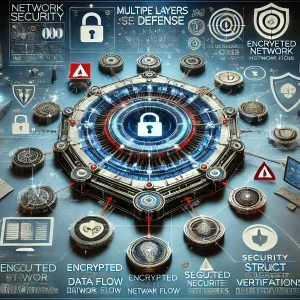
In an era where cyber threats are becoming increasingly sophisticated, traditional security models are proving inadequate. The need for a more robust and comprehensive security framework has given rise to Zero Trust Architectures. Unlike traditional security models that rely on a perimeter defense, Zero Trust Architectures operate on the principle of “never trust, always verify.” This blog delves into the core concepts of Zero Trust Architectures, their importance in modern cybersecurity, and practical steps to implement them effectively, securing the future of your organization.
Understanding Zero Trust Architectures
Zero Trust Architectures are security models that require strict identity verification for every person and device attempting to access resources on a private network, regardless of whether they are inside or outside the network perimeter. The traditional model of “trust but verify” is replaced with a “never trust, always verify” approach.
Key Principles of Zero Trust Architectures
- Verify Explicitly: Authenticate and authorize based on all available data points, including user identity, location, device health, and service or workload.
- Use Least Privilege Access: Limit user access with Just-In-Time and Just-Enough-Access (JIT/JEA), risk-based adaptive policies, and data protection to protect both data and productivity.
- Assume Breach: Minimize the blast radius and segment access. Verify end-to-end encryption and use analytics to gain visibility, drive threat detection, and improve defenses.
Importance of Zero Trust Architectures in Modern Cybersecurity
As organizations increasingly adopt cloud services, remote work, and bring-your-own-device (BYOD) policies, the traditional network perimeter becomes less relevant. This shift exposes vulnerabilities that cybercriminals can exploit. Zero Trust Architectures mitigate these risks by ensuring that every access request is thoroughly vetted.
Enhancing Security Posture
- Reduced Attack Surface: By limiting access to only what is necessary, the potential targets for an attacker are minimized.
- Improved Threat Detection: Continuous monitoring and analytics provide real-time insights into potential threats, enabling quicker response times.
- Compliance and Regulatory Benefits: Zero Trust Architectures help organizations comply with various regulatory requirements by ensuring strict access controls and data protection measures.
Steps to Implement Zero Trust Architectures
Implementing Zero Trust Architectures is a comprehensive process that requires careful planning and execution. Here are the key steps:
- Define the Protect Surface: Identify critical data, assets, applications, and services (DAAS) that need protection. Unlike the traditional approach of securing the entire network, focus on these critical elements.
- Map the Transaction Flows: Understand how data moves across your network. This knowledge helps in designing controls and policies that ensure security without disrupting business operations.
- Architect a Zero Trust Network: Develop a micro-perimeter around the protect surface using segmentation gateways and other technologies. This step involves defining policies and ensuring they are enforced consistently across the network.
- Create the Zero Trust Policy: Formulate policies based on the “who, what, when, where, and how” of access requests. These policies should be dynamic and adaptive, adjusting to the current threat landscape and user behavior.
- Monitor and Maintain: Continuous monitoring and real-time analytics are crucial for maintaining Zero Trust Architectures. This involves regular audits, updating policies, and using automation to respond to threats promptly.
Technologies and Tools for Zero Trust Architectures
Several technologies and tools support the implementation of Zero Trust Architectures:
- Identity and Access Management (IAM): Ensures that only authenticated and authorized users can access resources.
- Multi-Factor Authentication (MFA): Adds an extra layer of security by requiring multiple forms of verification.
- Network Segmentation: Divides the network into smaller segments to limit the lateral movement of threats.
- Encryption: Protects data both at rest and in transit.
- Endpoint Security: Ensures that devices accessing the network meet security standards.
- Security Information and Event Management (SIEM): Provides real-time monitoring and analysis of security alerts.
Case Study: Implementing Zero Trust Architectures at Company X
To understand the practical implementation of Zero Trust Architectures, let’s look at a case study of Company X, a multinational corporation facing significant cybersecurity challenges.
The Challenge
Company X had a traditional perimeter-based security model that struggled to protect its increasingly distributed and mobile workforce. Frequent security breaches and data leaks highlighted the need for a more robust security framework.
The Solution
- Assessment and Planning: Company X began by identifying its protect surface, including sensitive customer data and proprietary business applications.
- Technology Adoption: The company adopted IAM and MFA solutions to strengthen identity verification. Network segmentation was implemented to limit access to critical assets.
- Policy Development: Dynamic access policies were developed, focusing on least privilege and continuous verification.
- Monitoring and Response: SIEM solutions were integrated to provide real-time threat detection and response capabilities.
The Outcome
The implementation of Zero Trust Architectures significantly reduced security incidents at Company X. The company’s security posture improved, ensuring that only authorized users and devices could access sensitive resources. This shift not only protected critical data but also enhanced compliance with industry regulations.
Challenges and Considerations
While Zero Trust Architectures offer numerous benefits, their implementation comes with challenges:
- Complexity and Cost: Implementing Zero Trust Architectures can be complex and costly, requiring investment in new technologies and processes.
- Cultural Change: Shifting to a Zero Trust mindset requires a cultural change within the organization. Employees must be educated on the importance of strict access controls and continuous verification.
- Integration with Legacy Systems: Integrating Zero Trust Architectures with existing legacy systems can be challenging, often requiring significant modifications.
Future of Zero Trust Architectures: Securing the Future
As cyber threats continue to evolve, the importance of Zero Trust Architectures will only grow. Organizations must embrace this model to secure the future of their operations. Advances in artificial intelligence and machine learning will further enhance Zero Trust Architectures’ capabilities, enabling more sophisticated threat detection and response.
Conclusion
Zero Trust Architectures represent a paradigm shift in cybersecurity. By adopting a “never trust, always verify” approach, organizations can significantly enhance their security posture. Implementing Zero Trust Architectures requires careful planning, the right technologies, and a cultural shift towards continuous verification. As cyber threats become more sophisticated, Zero Trust Architectures are not just an option but a necessity for securing the future.





